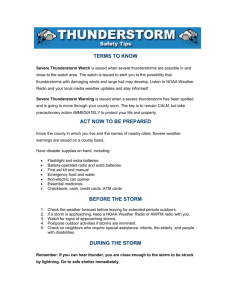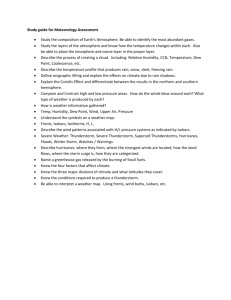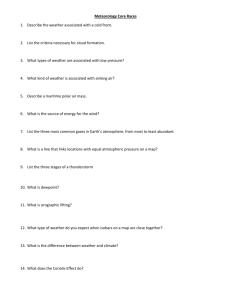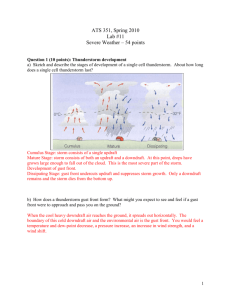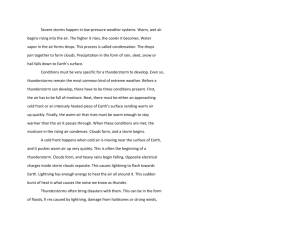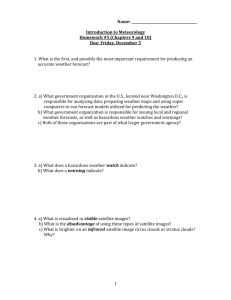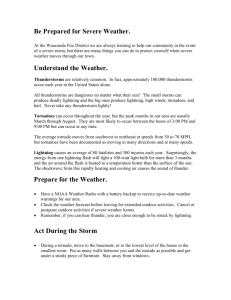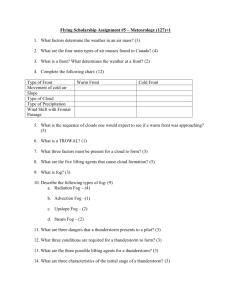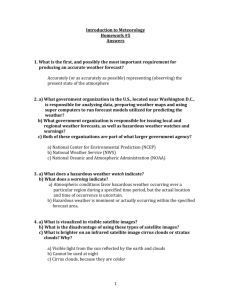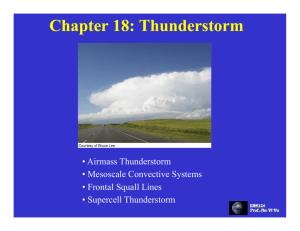Figures for Chapter 11
advertisement
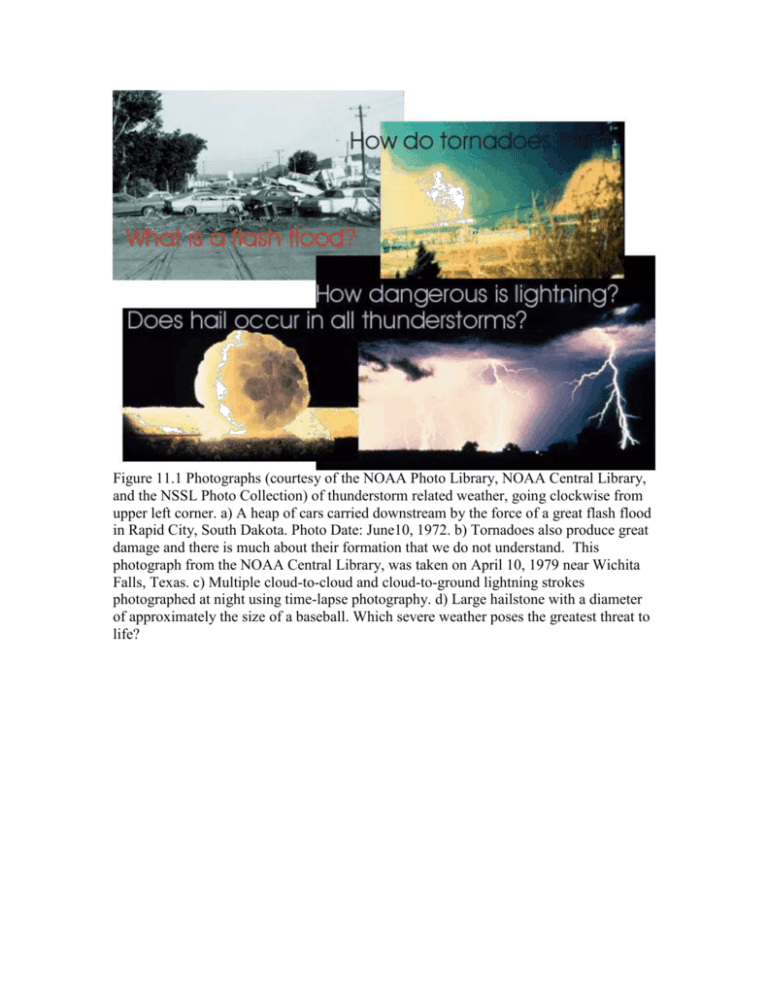
Figure 11.1 Photographs (courtesy of the NOAA Photo Library, NOAA Central Library, and the NSSL Photo Collection) of thunderstorm related weather, going clockwise from upper left corner. a) A heap of cars carried downstream by the force of a great flash flood in Rapid City, South Dakota. Photo Date: June10, 1972. b) Tornadoes also produce great damage and there is much about their formation that we do not understand. This photograph from the NOAA Central Library, was taken on April 10, 1979 near Wichita Falls, Texas. c) Multiple cloud-to-cloud and cloud-to-ground lightning strokes photographed at night using time-lapse photography. d) Large hailstone with a diameter of approximately the size of a baseball. Which severe weather poses the greatest threat to life? Figure 11.4 A satellite view of a thunderstorm at visible (top) and infrared (bottom) wavelengths. These storms occurred during the afternoon and evening of 21 January 1999. Arkansas experienced its largest tornado outbreak ever recorded during the month of January. Over 30 tornadoes were reported across the state (the strongest tornadoes have been rated at F3 on the Fujita Scale), with 8 fatalities. Baseball to grapefruit-sized hail was also reported at some locations. The cauliflower top is the overshooting top and the smoother cloud is the anvil. Figure 11.3 A photograph of a thunderstorm. Notice the anvil and the overshooting top. (http://www.inclouds.com/Wx/supercell.html) Figure 11.4 (PHOTO OF TORNADO DESTRUCTION (I can get one from NOAA archives)) Figure 11.5 (PHOTO OF HAIL DESTRUCTION (I can get one from NOAA archives) Figure 11.6 The global distribution of thunderstorms over land. A thunderstorm day is a calendar day on which thunder was heard. The thunder may have come from one storm or several. On average about 1,500 thunderstorms are active worldwide at any given time. Figure 11.7 The distribution of thunderstorm days in the United States. (Can we combine these two figures together, one show the total and the other the seasonal distribution?) Figure 11.8 The average number of days with large hail, larger than 3/4 of an inch, each year in the United States. Compare this figure with Figure 11.7. Figure 11.9 A plot of temperature and dew point versus altitude for a very unstable environment. Notice the warm dry air near the surface and the cooler drier air in the middle troposphere. Figure 11.10 A photograph of ordinary cumulus cells that are developing on the plains of Colorado. Singlecell Storm Supercell Long-lived, severe Ordinary Cell short lived, non-severe Airmass thunderstorm Multicell Storm Cluster of single cells All ordinary Cells Figure 11.12 Classification of thunderstorm types. Comprised of ordinary and Supercells Line of single cells All supercells (very rare) Figure 11.13 A thunderstorm cell undergoes a sequence of three stages: cumulus, mature, and dissipating. Figure 11.14 (SATELLITE PHOTO OF AN AIRMASS THUNDERSTORMs over Florida.) As indicated by this satellite image, airmass thunderstorms are common over Florida during summer. Figure 11.15 (Photograph of a supercell thunderstorms). Supercell thunderstorms can last for several hours. (I can get one from NOAA archives) Figure 11.16 Gust fronts help to lift the updraft into the thunderstorm. A roll cloud can mark the position of the gust front and thus herald a changing weather condition. Figure 12.11 The approach of a severe thunderstorm is often ominous. (PHOTO of a severe thunderstorm). (I can get one from NOAA archives) Figure 11.17 a) Vertical wind directional shear is a rapid change in wind direction with altitude. b) A change in wind speed with altitude generates a vertical wind speed shear. Figure 11.18 A roll cloud is an ominous sign of weather to come. (Need photo here as well). (I can get one from NOAA archives) Figure 11.19 The circulation of air in a supercell thunderstorm. Notice how the updraft (purple) and downdraft (green) are in different regions of the storm. The upper diagram is a view of the storm from above, the bottom a side-view. (Three perspectives of the same thing.) Figure 11.20 The Multicell thunderstorm contains cells in various stages of development: cumulus, mature, dissipating. The red arrows represent the updraft and the blue arrows the downdraft. The storm is moving from left to right. Figure 11.21. The downdraft of thunderstorm cells in an MCC assist in the development of updrafts of other storms. (Don't vertically stack the time sequence.) Figure 11.22 This Shuttle photograph, taken in April 1984,is shows a convective line of thunderstorms associated with a passing cold front over Florida, U.A.A. A shadow from the height of the thunderstorms, caused by early morning sunlight, can be seen traversing the scene southwest to northeast. Some of these storms were estimated to reach heights in excess of 40 000 feet (12 000 meters). At the time this photograph was taken, weather stations across Florida reported severe thunderstorms, strong winds, hail, torrential rains, and numerous tornadoes. (NASA image: STS41C-040-2130) Figure 11.23. The air flow favorable for the formation of squall lines. The mT and cT air masses form what is referred to as a dry line. The jet stream is needed to provide upper level divergence. Figure 11.24 Air flow through a mature thunderstorm cell of a squall line. The picture to the right is of a squall line, the line A-B denotes the cross-section through the thunderstorm shown on the left. This storm is at the mature stage. Storms along the southwest edge are in the cumulus stage while those along the northeast edge are in dissipation stage. (Maybe use a satellite image for the left hand panel.) Figure 11.25 A Mesoscale Convective Complex, abbreviated MCC, is easily indentified in this satellite infrared image. The images is color enhance to highlight the cold cloud top temperatures. Also shown are the wind directions at 250 mb, indicating that the MCC is occurring in the vicinity of an upper-level ridge. (We want to include some of the 250 mb wind fields shown in the bottom image in the top one.) Figure 11.26 Favorable conditions for the formation of a Mesoscale Convective Complex (MCC). MCCs form to the west of an upper level ridge and requires inflow or warm and moist air at low-levels near the ground. Figure 11.27 The formation of the low-level jet that supplies moisture to thunderstorms results, in part, to the geographic structure of North America. At a given elevation the air to the west is colder than the air over the Mississippi Valley, generating a pressure gradient force from the east to the west. The Coriolis force turns the wind to the right and helps to generate the low-level southerly jet. (Can we add a surface inversion below the jet stream, along with pressure surfaces?) Figure 11.28 A sequence of events that leads to a cloud-to-ground lightning stroke. A) Charges collect in the base of the cloud. B) The ground is normally negatively charged; however, as the negative charges build up near the base of the cloud, they repel the negative charges on the ground, making the ground positively charged. C). (See also figure 11-2, page 269 in Aquado and Bert). Ringing church bells in a steeple is generally not safe during a thunderstorm. (a) (b) (c) Figure 11.29 Just as moving your hands (a) to make a pencil rotate, moving air can cause a volume of air to rotate or spin (b). Tornado formation can result from spinning tube of air. To accomplish this the rotating vortex of air must be lifted vertically by storm updraft (c). Figure 11.30 Wall clouds and funnels are signs of favorable conditions for tornado formation. (PHOTOGRAPH OF WALL and FUNNEL CLOUD) Figure 11.31 A hook echo observed in a radar image of severe thunderstorm indicates rotation and favorable conditions to spawn a tornado. Figure 11.32 Photograph of a flood damage. Figure 11.33 A hailstone cut in half reveals concentric rings of clear and white ice. This provides a clue to how these stones form. Figure 11.34 The path of hailstones in a supercell thunderstorm. (Want to combine these two- the top doesn't include any of the cloud) Figure 11.35 A time sequence showing a hailshaft as it moves through a storm.
